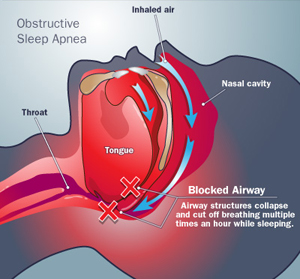Sleep apnea is a condition where breathing becomes intermittently obstructed while we sleep. This can be caused by having a narrowed upper airway (for example, due to large tonsils or a smaller lower jaw), but most commonly, carrying excess body weight is the culprit. Excess tissue around the neck puts additional pressure on the upper airway structures, and excess weight on the chest and around the abdomen results in lower lung volumes and therefore less ‘pull’ (negative intrathoracic pressure) generated to suck air through the airway and into the lungs.
While estimates vary, studies have suggested that about a third of adults with a BMI of 30 or greater, and about half of people with a BMI of 40 or greater, have sleep apnea (and it affects kids with obesity too).
Obstructive sleep apnea has many negative health consequences. Because people with sleep apnea are not getting enough oxygen while sleeping, sleep is inadequate and the body become stressed, leading to increases in cortisol, decreases in leptin, and increases in the hunger hormone ghrelin, to name a few. This promotes a vicious cycle of weight gain, which makes the sleep apnea worse. Along with these hormone changes and stresses on the heart, there is an increased risk of stroke, heart failure, diabetes, and many other serious health conditions. People with severe untreated sleep apnea have a 2-3 fold increased risk of death compared to people without sleep apnea, independent of other risk factors such as obesity or heart disease.
Sadly, obstructive sleep apnea is not tested for often enough. I think this is due to health care professionals not thinking about it often enough, and, based on my clinical experience, possibly due a resistance on the part of patients themselves to consider or admit that they may suffer from this condition. More on this next week – stay tuned.
Follow me on twitter! @drsuepedersen
